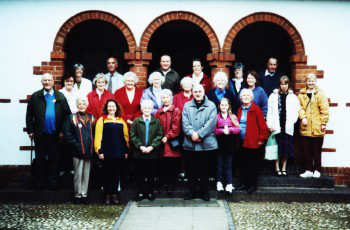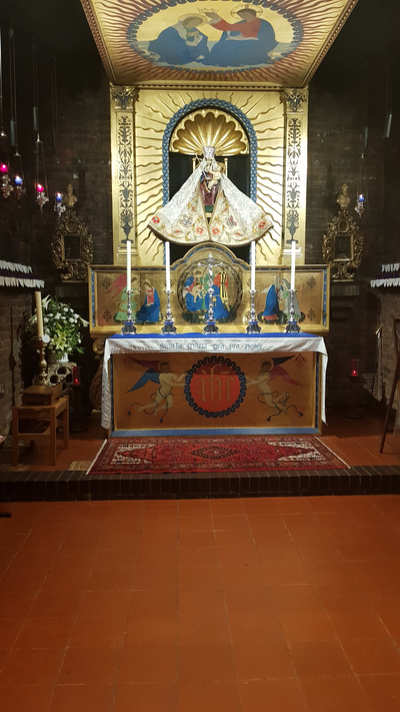Amongst the many Church highlights that have not been able to take place this year, the Annual Pilgrimage to Walsingham is included on the list; probably the only time the Pilgrimage has not taken place in living memory. We hope to be visiting the shrine in 2021; meanwhile here is an account by Rod Dawson of the Pilgrimage which took place twenty years ago in the year of the Millennium...
In his prologue to The Canterbury Tales, Geoffrey Chaucer notes that April is the favoured time for people to fulfil a need to go on pilgrimages. This is the time, he suggests, when the winds of March give way to the soft showers of April and a reflowering of the earth in spring, co-inciding with the movable feast of Easter, which opens a yearning in folk for spiritual awakening, to shake off the dross of the past and make vows of virtue for their future conduct...
So it was with a happy band of parishioners, over 20 strong, from our church of St George the Martyr, Waterlooville, to set forth by coach in late April in this Year of Grace 2000 to visit the Holy Shrine of Our Lady of Walsingham in Norfolk. At the start, our leader Fr Malcolm conducted a blessing and we enjoyed a relatively uneventful journey to Norfolk in a roomy and comfortable coach.
Walsingham has been a place of pilgrimage for almost 1,000 years. Legend has it that, in the year 1061, the Lady Richeldis of that manor was visited at prayer by the Blessed Virgin Mary, with direction to build a replica of the home of Jesus of Nazareth on the land at Walsingham. The dream persisted, the house was constructed, and the place became a focus for medieval pilgrims. Various changes occurred through time, including much destruction and desecration, often prompted by rivalries and power struggles between church and state and christians of different persuasions. And yet, throughout all the suffering and tensions, has emerged an impressive, reverential Shrine of Our Lady of Walsingham which attracts hundreds of thousands of pilgrims and other visitors every year and which exerts a profound influence on all who attend there - for whatever individual cause.
The modern building has a modest red-roofed frontage with an entrance of three Normanesque arches. Other buildings and open areas, for worship, socialising, eating and drinking, recreation or accommodation, are nearby, all being harmoniously integrated into a village of beauty and peace. The Holy House, which contains the Image of Our Lady, is within the Shrine Church. The Church has fifteen chapels, one for each mystery of the Rosary. These are in three groups of five - The Joyful Mysteries, the Sorrowful Mysteries and the Glorious Mysteries. Other features include the Holy Well, the Stations of the Cross in the gardens and grounds, and the All Souls' Chapel. In the locality, and some at a few miles distant are notable churches of other traditions - the Russian Orthodox, the Methodist and Roman Catholic. This latter is situated just over a mile away, was the final stopping place of early pilgrims before they entered Walsingham, and contains the Slipper Chapel and a shrine to Our Lady within a pleasant and inviting complex.
During the three action-packed days the group members engaged in worship, met others to share experiences, to commiserate where appropriate and to help and comfort where required. They took part in the rites and ceremonies, which included:
• The Eucharist
• Devotions
• Processions by candlelight and with singing
• Laying on of hands
• Sprinkling at the Holy Well
• Anointing, especially for the sick and afflicted
• Stations of the Cross
• Intercessions and Confessions
all with due reverence and solemnity. Reports afterwards indicated immense emotional heightening, shared with fellow pilgrims in an atmosphere of hegemony.
There were happenings both for comment and for marvel, as for example:
• the family who decided to walk the pilgrims' way barefoot, not realising that traditionally this would be done on a mud track. On this occasion it was on a sharp-shingle roadway!
• the penitent who knelt on the bare stone floor throughout the divine service and was unable to get up afterwards.
• our dear Fr Malcolm, who braved strong wind and rain in the early morning in order to visit Houghton St Giles and there to retrieve a record of the female saints and doctors of the church, all of whose faces had been roughly obscured during the Reformation.
• the reader of part of the Gospel according to St John, a pivotal passage, who forgot his reading glasses and had to borrow some (of the wrong magnification) from another member of the congregation.
The group also had a great deal of recreation and fun:
• those few who went to the steam fair at Thursford and danced to the fairground music, ate ice creams, went on the carousel rides and generally cavorted like children freed from parental supervision for the day.
• those who walked to Wells-next-the-Sea and came back on the Light Railway, where observant ones noticed that the engine was called The Norfolk Hero, referring to Admiral Lord Nelson, with connections to Portsmouth.
• the one or two who decided to ‘get a few in’ at a watering place before the rigours of religious rites could overwhelm them. Other opportunities arose to imbibe at the local hostelries.
• the excuse for a party. This time it was the birthday of one of our number, celebrated over many hours with great revelry and noise.
Why go on pilgrimages? When asked directly, many people became strangely inarticulate, resorting to well-worn phrases or platitudes. They reverted to ...“we’ve been coming here for the last n years”, “we usually come at this time with the St Albans’ crowd but...” or “I need a bit of peace and quiet”. There were the mundane explanations - “it’s the only time we can get away for a few days” or “it is such a lovely place to be in and the people are so friendly and nice”, and the spiritual - “the candle-light procession was such a moving experience”,“I’m praying for... to be healed”, “I find total renewal and refreshment here”.. The reasons should not be pressed for they are not susceptible to close and logical analysis. The occasion is indeed a wonderful and uplifting experience with a multiplicity of layers, from - religious, moral, spiritual at the high level, and social, medical and recreational at the lower. Perhaps our quest can be summed up in the admonition of Mother Teresa that from time-to-time we need to:
“do something beautiful for God.”
Rod Dawson






